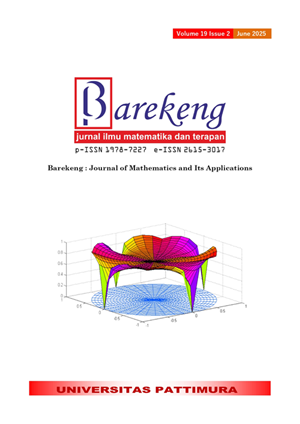SUSCEPTIBLE VACCINATED INFECTED RECOVERED MODEL WITH THE EXCLUSIVE BREASTFEEDING AND ITS APPLICATION TO PNEUMONIA DATA IN INDONESIA
Abstract
The spread of infectious diseases can occur directly or indirectly. Pneumonia is an infectious respiratory tract disease. Indonesia is among the top 10 countries in the world concerning deaths caused by pneumonia. The spread of infectious diseases can be prevented through vaccination and exclusive breastfeeding, which play a role in providing body immunity. This study aims to formulate an SVIR model with exclusive breastfeeding, apply it to pneumonia in Indonesia, and determine its spread pattern and interpretation regarding the target of free pneumonia by 2030. The methods used were literature and applied studies. Through literature studies, the characteristics of infectious diseases were identified, assumptions and parameters of the model were added, and relationships between variables were determined. The applied method was to estimate the parameters and initial values of the model based on annual data on pneumonia disease in Indonesia. The formulated model is a system of first-order nonlinear differential equations. The model is applied to pneumonia based on annual data from 2013 to 2022 in Indonesia, and its solution is determined using the fourth-order Runge-Kutta method. Based on the model solution and 2021-2022 data, a MAPE value of 15% is obtained, indicating that the model is sufficiently accurate in explaining the spread of pneumonia in Indonesia. The spread pattern of pneumonia in Indonesia from 2013 to 2030 indicates a downward. However, as of 2030, there are still 67,261 individuals infected, indicating that the target of pneumonia-free Indonesia has not been achieved. Simulation shows that with exclusive breastfeeding rate value = 0.438852 and Hib vaccination rate = 0.25 it is estimated that the target of free pneumonia in Indonesia in 2030 will be achieved. The free target can also be achieved by increasing the exclusive breastfeeding rate to 73.9% and the Hib vaccination rate to 0.22.
Downloads
References
S. Notoatmodjo, ILMU KESEHATAN MASYARAKAT (PRINSIP-PRINSIP DASAR), Cetakan Kedua, Jakarta: Rineka Cipta, 2003.
IDAI, "AIR SUSU DAN KEKEBELAN TUBUH," [Online]. Available: https://www.idai.or.id. [Accessed 25 January 2023].
W. H. O. (WHO), "EXCLUSIVE BREASTFEEDING," WHO, [Online]. Available: htttps://www.who.int. [Accessed 27 November 2022].
P. R. INDONESIA, "TENTANG PELAKSANAAN PENCAPAIAN TUJUAN PEMBANGUNAN BERKELANJUTAN," 2017.
W. Kermack and A. McKendrick, " A CONTRIBUTION TO THE MATHEMATICAL THEORY OF EPIDEMICS," in Proceedings of the Royal Society of London 115, London, 1927.
H. Hethcote, in THREE BASIC EPIDEMIOLOGICAL MODELS, Applied Mathematical Ecology 18, 1989, pp. 119-144.
S. Chauhan, O. P. Misra and J. Dhar, "STABILITY ANALYSIS OF SIR MODEL WITH VACCINATION," American journal of computational and applied mathematics 4.1, pp. 17-23, 2014.
L. X., T. Y. and Iwani S., "SVIR EPIDEMICS MODELS WITH VACCINATION STRATEGIES," Journal of Theoritical Biology 253, pp. 1-11, 2008.
S. Islam, "EQUILIBRIUMS AND STABILITY OF SVIR EPIDEMIC MODEL," International Journal of Humanities, Arts, Medicine, and Sciences 3, pp. 1-10, 2015.
I. Aryani and P. Widyaningsih, "MODEL SUSCEPTIBLE VACCINATED INFECTED RECOVERED (SVIR) DAN PENERAPANNYA PADA PENYAKIT DIFTERI DI INDONESIA," PRISMA, Prosiding Seminar Nasional Matematika, pp. 156-162, 2020.
J. Wei, Juquan Wang and X. Wang, "ANALYSIS OF EPIDEMIC VACCINATION DILEMMA CONSIDERING PATHOGEN EVOLUTION BASED ON SVIR MODEL AND EVOLUTIONARY GAME," International Journal of Nonlinear Science 34.2, no. 3, pp. 49-54, 2023.
P. Widyaningsih, A. Ivanni and N. Arfawi Kurdi, "SUSCEPTIBLE VACCINATED INFECTED RECOVERED SUSCEPTIBLE MODEL: EQUILIBRIA POINTS AND APPLICATION ON COVID-19 CASE DATA IN INDONESIA," BAREKENG: Journal of Mathematics and Its Applications, vol. 18, no. 3, pp. 1607-1614, 2024.
P. Widyaningsih, S. R. Yumaroh and D. S. Saputro, "SPREADING PATTERN OF INFECTIOUS DISEASES: SUSCEPTIBLE INFECTED RECOVERED MODEL WITH VACCINATION AND DRUG-RESISTANT CASES (APPLICATION ON TB DATA IN INDONESIA)," Journal of Mathematics and Its Applications, vol. 18, no. 1, pp. 0467-0474, 2024.
P. D. d. I. K. RI, "PROFIL KESEHATAN INDONESIA," Kementerian Kesehatan Republik Indonesia, Jakarta, 2013-2022.
WHO, World Health Organization, [Online]. Available: www.who.int. [Accessed 27 November 2023].
T. R. 2018, "LAPORAN NASIONAL RISKESDAS 2018," Kementerian Kesehatan Republik Indonesia, Jakarta, 2018.
C. f. D. C. a. P. (CDC), "ABOUT HIB VACCIN," [Online]. Available: http://www.cdc.gov. [Accessed 15 April 2023].
W. B. Data, "BIRTH AND DEATH RATE," [Online]. Available: http://data.worldbank.org. [Accessed 23 January 2023].
UNICEF, "BREASTFEEDING ACTS BABYS FIRST VACCINE-PROVIDING CRITICAL PROTECTION DISEASES," [Online]. Available: https://www.unicef.org. [Accessed 19 April 2023].
C. Lewis, INDUSTRIAL AND BUSINESS FORECASTING METHODS: A PRACTICAL GUIDE TO EXPONENTIAL SMOOTHING AND CURVE FITTING, Oxford: Butterworth-Heinemann, 1982.
B. P. S. Indonesia, "PERSENTASE BAYI USIA KURANG DARI 6 BULAN YANG MENDAPATKAN ASI EKSKLUSIF MENURUT PROVINSI (PERSEN) 2021-2023," 2 January 2024. [Online]. Available: https://www.bps.go.id. [Accessed 18 April 2024].
Copyright (c) 2025 Purnami Widyaningsih, Ghufron Musta'in, Dewi Retno Sari Saputro

This work is licensed under a Creative Commons Attribution-ShareAlike 4.0 International License.
Authors who publish with this Journal agree to the following terms:
- Author retain copyright and grant the journal right of first publication with the work simultaneously licensed under a creative commons attribution license that allow others to share the work within an acknowledgement of the work’s authorship and initial publication of this journal.
- Authors are able to enter into separate, additional contractual arrangement for the non-exclusive distribution of the journal’s published version of the work (e.g. acknowledgement of its initial publication in this journal).
- Authors are permitted and encouraged to post their work online (e.g. in institutional repositories or on their websites) prior to and during the submission process, as it can lead to productive exchanges, as well as earlier and greater citation of published works.






1.gif)



